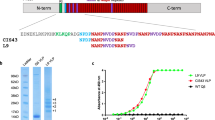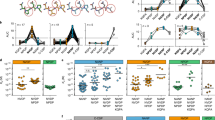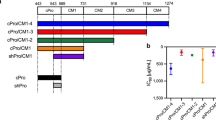Abstract
Synthetic peptides are potential vaccine candidates because they may be able to induce high antibody titres and specific cellular immune responses against native proteins and thus the whole invading organism1. In a previous study we showed that immunization with molecules of relative molecular mass (Mr) 155,000 (155K) 83K, 55K and 35K, specific for the late schizont and merozoite stages of Plasmodium falciparum, could elicit either partial or total protection in Aotus trivirgatus monkeys experimentally infected with P. falciparum2. Here we have chemically synthesized 18 peptides corresponding to different fragments of these proteins to immunize Aotus trivirgatus monkeys. Some peptides gave partial protection from challenge with P. falciparum parasites, but none provided complete protection individually. A combination of three partially protective peptides gave complete or almost complete protection, however, suggesting that this particular combination of peptides is a good candidate for a malaria vaccine.
This is a preview of subscription content, access via your institution
Access options
Subscribe to this journal
Receive 51 print issues and online access
$199.00 per year
only $3.90 per issue
Buy this article
- Purchase on Springer Link
- Instant access to full article PDF
Prices may be subject to local taxes which are calculated during checkout
Similar content being viewed by others
Author information
Authors and Affiliations
Rights and permissions
About this article
Cite this article
Patarroyo, M., Romero, P., Torres, M. et al. Induction of protective immunity against experimental infection with malaria using synthetic peptides. Nature 328, 629–632 (1987). https://doi.org/10.1038/328629a0
Received:
Accepted:
Issue Date:
DOI: https://doi.org/10.1038/328629a0
This article is cited by
-
A comprehensive and critical overview of schistosomiasis vaccine candidates
Journal of Parasitic Diseases (2021)
-
Effects of transmission-blocking vaccines simultaneously targeting pre- and post-fertilization antigens in the rodent malaria parasite Plasmodium yoelii
Parasites & Vectors (2016)
-
Reference strand conformational analysis (RSCA) is a valuable tool in identifying MHC-DRB sequences in three species of Aotus monkeys
Immunogenetics (2006)
-
MHC class I genes in the owl monkey: mosaic organisation, convergence and loci diversity
Immunogenetics (2005)
-
Identifying and structurally characterizing CD1b in Aotus nancymaae owl monkeys
Immunogenetics (2004)
Comments
By submitting a comment you agree to abide by our Terms and Community Guidelines. If you find something abusive or that does not comply with our terms or guidelines please flag it as inappropriate.



